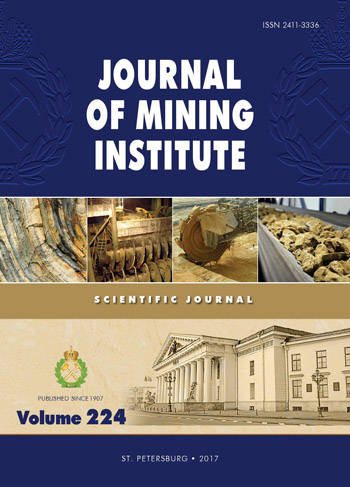Method of determining characteristics for air heating system in railway tunnels in harsh climatic conditions
- 1 — Ph.D., Dr.Sci. professor Saint-Petersburg Mining University
- 2 — Ph.D. chief engineer Saint-Petersburg Mining University
Abstract
The article describes climatic and mining-technical conditions influencing frost formation process. It was noted that the radical tools for preventing frost formation in winter periods is creation of positive temperature in tunnels by heating the incoming outside air. We formulated tasks, which solution will promote development of engineering calculation method for heating systems parameters. The article provides results of theoretical studies based on mathematical modelling and analytical solutions and data on field instrumental measurements, which were processed with similarity criteria. It compares mathematical modelling results on determining amount of tunnel incoming air flow with portal gates and calculations data from experimentally determined coefficient of local resistance. We proved the energy efficiency of placing the tunnel portal gates and validated the places of preheated air injection points and removal of cool air from this flow, which provides maximal energy effect.
References
- Венгеров И.Р. Метод пересчета для задач горной теплофизики. /Создание безопас-ных условий труда в угольных шахтах. Макеевка-Донбасс, 1985. С.50-52
- Гендлер С.Г. Принципы создания теплового режима. Метрострой, №5, 1989. С.19-20.
- Гендлер С.Г. Тепловой режим подземных сооружений. /Уч. пособие. Изд. ЛГИ, 1987. - 101 с.
- Гендлер С.Г. Управление тепловым режимом тоннелей в суровых климатических условиях. Транспортное строительство, №11, 1991. С.15-17.
- Гендлер С.Г., Плескунов В.А. Влияние поршневого эффекта подвижного состава на проветривание тоннелей / Социально-экономические и экологические проблемы горной промышленности, строительства и энергетики: Материалы 6 - ой Международной Конфе-ренции по проблемам горной промышленности, строительства и энергетики. – Тула: Тул-ГУ. - 2010. – Т.1. – с. 85-88.
- Гендлер С.Г., Синявина С.В. Особенности управления вентиляционным режимом нового Байкальского железнодорожного тоннеля / Горный информационно-аналитический бюллетень. - М: Горная книга. - 2015. - Горный институт (МГИ) МИСиС. - № 11. - 2015 г. - с. 173-179.
- Гендлер С.Г., Синявина С.В. Управление тепловым режимом железнодорожных тоннелей, расположенных в суровых климатических условиях / Горный информационно-аналитический бюллетень. - М: Горная книга, - 2015. - «Промышленная безопасность предприятий минерально-сырьевого комплекса в XXI веке». - Специальный выпуск №7. – с. 32-38.
- Главатских В.А. К вопросу определения расчетных температур воздуха в железно-дорожных тоннелях, расположенных в районах с суровыми климатическими условиями. /Исследование работы искусственных сооружений. Труды НИИЖТа, Новосибирск, вып.186, 1977. С.136-143.
- Дядькин Ю.Д. Основы горной теплофизики для шахт и рудников Севера. М.: Не-дра, 1968. 256 с.
- Михеев Н.И. Метод и результаты оценки параметров модели турбулентности k-ε на основе экспериментальных полей скоростей / Труды Академэнерго. – 2013. - №3.
- Руководство пользователя. ANSYS Fluent Theory Guide. Издательство ANSYS, Inc., Southpointe, 2013 г., 780 с.
- Третьяков Ю.Н., Славин Б.Е., Протасов Н.Н. Некоторые рекомендации по предот-вращению промерзания дренажных и железнодорожных тоннелей в зимнее время. / Труды Всесоюзного совещания семинара по обмену опытом строительства в суровых климатических условиях. Т.7, вып.4, Красноярск, 1970. С.123-128.
- Щербань А.Н., Кремнев О.А. Научные основы расчета и регулирования теплового режима глубоких шахт. Т.1. Киев, Изд-во АН СССР, 1959. 431 с.
- Gendler S.G. Control for heat regime of the railway tunnels located in severe climatic condition. 9th International Conference on Aerodynamics and Ventilation of Vehicle of Vehicle Tunnels, 1997, ITALY, pp. 397-411
- Gendler S.G., Sokolov V.A. The results of ventilation tests during practical use of the Se-veromujsky railway tunnel. BHRg 12th International Symposium Aerodynamics and Ventilation of Vehicle Tunnels, 2006, Portoroz, Slovenia, pp. 451-462.
- Roche L. Meteorological influence on tunnel ventilation: Tree new field experiments. 7th Int. Sim. on the Aerodynamics and Ventilation of Vehicle Tunnels, 1991, UK, pp.513-543.
- Takeo I. Faceless of the Seikan Tunnel / I. Takeo, K. Shouichi, K. Tadoo. - Japanese Railway Eng. - 1988. - № 106.
- Weiss H H and Dolejsky K, ‘An investigation of the atmospheric pressure differences af-fecting the longitudinal ventilation of road tunnels’, Paper D1, 5th International Symposium on the Aerodynamics and Ventilation of Vehicle Tunnels, Organised by BHRG, France, May 1985.
- West А., C.W. Pope, ‘Wind induced flow and resistance measurements in a rock hewn tunnel’, Paper D3, 5th International Symposium on the Aerodynamics and Ventilation of Vehicle Tunnels, Organised by BHRG, France, May 1985.


